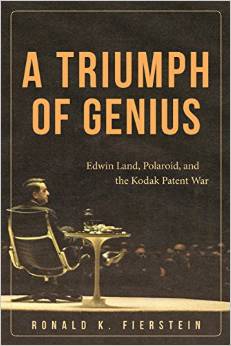 On Tuesday, January 13, 2015, the Federal Circuit Court of Appeals affirmed a damages award in excess of $1 billion to be paid by W.L Gore & Associates, Inc. to C.R Bard Inc. for infringing its blood vessel graft patent. See Bard Peripheral Vascular, Inc. v. W.L. Gore & Associates, Inc. In so doing, the court unseated the previous long-standing record holder, the amount just under $1 billion won by Polaroid in 1990 from its epic patent litigation with Eastman Kodak in the late 70s and early 80s that had stood for almost twenty-five years as the largest satisfied judgment awarded by a court in a patent infringement case in American history. Other cases had come close over the years, including the damages awarded to Apple Computer in its much-publicized patent victory against rival Samsung over features in its iPhone, but none had eclipsed Polaroid’s victory until now.
On Tuesday, January 13, 2015, the Federal Circuit Court of Appeals affirmed a damages award in excess of $1 billion to be paid by W.L Gore & Associates, Inc. to C.R Bard Inc. for infringing its blood vessel graft patent. See Bard Peripheral Vascular, Inc. v. W.L. Gore & Associates, Inc. In so doing, the court unseated the previous long-standing record holder, the amount just under $1 billion won by Polaroid in 1990 from its epic patent litigation with Eastman Kodak in the late 70s and early 80s that had stood for almost twenty-five years as the largest satisfied judgment awarded by a court in a patent infringement case in American history. Other cases had come close over the years, including the damages awarded to Apple Computer in its much-publicized patent victory against rival Samsung over features in its iPhone, but none had eclipsed Polaroid’s victory until now.
Of course, the substantial victories won by Bard and Apple do not match Polaroid’s in another very significant way. Polaroid was successful in securing an injunction against further infringement by Kodak that forced the goliath of the photography industry to withdraw all of its instant cameras and film from store shelves across the country. The courts imposed this punishment even though more than thirteen million Americans owned Kodak instant cameras that were immediately rendered useless by the decision. While neither Bard nor Apple was unable to secure this remedy, observers have nonetheless viewed these victories as significant for the technology community. At the very least, Bard and Apple will receive sizeable royalties for the unlawful misappropriation of the innovative features they had pioneered.
The ability of both companies to rely on its patents to protect its innovations is not something either could take for granted. In large part, they owe a debt to Edwin Land, the founder of Polaroid, and role he played over the decades as a champion of patents. The climax of this pursuit was the hard fought litigation his company waged against Eastman Kodak over the technology embodied in Polaroid’s revolutionary SX-70 instant camera and film. That case marked a very significant milestone in the ever-developing area of patent law. Polaroid’s reliance on its patents to protect its signaled a shift from what had been considered an anti-patent era in the mid-20th century, to a new period in which patents regained their importance as intellectual property protection for technology companies.
During the era that came after the great technological achievements of innovators like Bell, Edison and Ford, courts were seen as being pro-inventor, and pro-patent. However, in the 1930s and 1940s a new concern arose, the danger of monopolies. A fear began to arise that large companies could monopolize fields by buying up patents, and so patents suffered as a result. The government issued fewer patents, and more patents were invalidated when challenged in court.
By the early 1980s, however, “the overemphasis of antitrust feeling prevalent in the 1970s … [and earlier began] abating,” noted Michael Bloomer, Executive Director of the American Intellectual Law Association (AILA). Congress recognized and addressed the issue, forming the Federal Circuit Court of Appeals in October 1982 to handle, among other things, all patent appeals, a move designed to provide more certainty and uniformity in patent law and, ultimately, “fair and consistent rulings.” Chief Judge Markey denied accusations that the new court’s intention was to be “blatantly pro-patent.” “We’re pro-law, but we’re not pro-patent,” he insisted.
 Nonetheless, it was clear that a new era took hold in the mid-1980s, and many looked on the result in the Polaroid v. Kodak case as the turning point. The New York Times declared, “The Kodak-Polaroid patent dispute is the most prominent example of an increasingly pro-patent sentiment in American Courts.” The effect on America’s technology community was clear. A patent attorney at Apple Computer told the Wall Street Journal that the result “shows that the patent system is alive, well and very vibrant for those who have inventions.” In 1986, in response to the decision, Fortune interviewed over 100 business executives and lawyers and detected “a growing respect for the power of patents and recognition of the need to manage differently as a result.” AILA Executive Director Bloomer put it succinctly: “A district court put Kodak out of the instant camera business in one day … That’s something chief executives understand.” When interviewed about the trend, Herbert F. Schwartz, Polaroid’s lead counsel stressed that, in words that would surely have elicited a satisfied nod from Edwin Land, “the emphasis [in this new era] is on protecting a climate for innovation.”
Nonetheless, it was clear that a new era took hold in the mid-1980s, and many looked on the result in the Polaroid v. Kodak case as the turning point. The New York Times declared, “The Kodak-Polaroid patent dispute is the most prominent example of an increasingly pro-patent sentiment in American Courts.” The effect on America’s technology community was clear. A patent attorney at Apple Computer told the Wall Street Journal that the result “shows that the patent system is alive, well and very vibrant for those who have inventions.” In 1986, in response to the decision, Fortune interviewed over 100 business executives and lawyers and detected “a growing respect for the power of patents and recognition of the need to manage differently as a result.” AILA Executive Director Bloomer put it succinctly: “A district court put Kodak out of the instant camera business in one day … That’s something chief executives understand.” When interviewed about the trend, Herbert F. Schwartz, Polaroid’s lead counsel stressed that, in words that would surely have elicited a satisfied nod from Edwin Land, “the emphasis [in this new era] is on protecting a climate for innovation.”
C.R. Card, Apple Computer, and other innovative American technology companies are reaping the benefit of Edwin Land’s and Polaroid’s historic success in the courts, and are employing the patent system in the way our founding fathers intended; to secure for innovators the right to the fruits of their labor.
Editorial Note: For more on Polaroid v. Kodak please see A Triumph of Genius: Edwin Land, Polaroid, and the Kodak Patent War.

![[IPWatchdog Logo]](https://ipwatchdog.com/wp-content/themes/IPWatchdog%20-%202023/assets/images/temp/logo-small@2x.png)

![[Advertisement]](https://ipwatchdog.com/wp-content/uploads/2024/04/Patent-Litigation-Masters-2024-sidebar-early-bird-ends-Apr-21-last-chance-700x500-1.jpg)

![[Advertisement]](https://ipwatchdog.com/wp-content/uploads/2021/12/WEBINAR-336-x-280-px.png)
![[Advertisement]](https://ipwatchdog.com/wp-content/uploads/2021/12/2021-Patent-Practice-on-Demand-recorded-Feb-2021-336-x-280.jpg)
![[Advertisement]](https://ipwatchdog.com/wp-content/uploads/2021/12/Ad-4-The-Invent-Patent-System™.png)







Join the Discussion
6 comments so far.
Anon
April 13, 2015 11:57 amI think that Juan is simply too clever by half.
In attempting to downplay the importance of patents and innovation, he inadvertently highlights one of the strengths – and concurrently – removes (at least) one of the anti-patent arguments.
An anti view could focus (as Juan seemingly does) on the lack of sustained market strength. Or, an anti view could focus on a shorter term “the penalty was too high.”
Both are clear error.
There is nothing that mandates that the leverage provided by patents MUST be such that the market is overpowered and MUST be enthralled to the holder of the patent.
This is actually the beauty of the system. It is also why those who use the word “monopoly” too loosely should take better heed to understand the patent system.
A patent is only a negative right, and the market – including competitors ALWAYS have several options:
1) pay up to what the inventor asks for (IF the inventor decides to even ask for something)
2) do without
3) design around.
The beauty of a STRONG patent system reverberates most resoundingly with the thing that many today wish to use as a negative: the blocking effect.
Much like a strong river, man’s innate desire to better himself and innovate is NOT in fact stopped by strong patents. Rather, the blocking effect (something which should be embraced rather than feared) should be seen in its proper role as a stimulus to even more creative innovation (as the adage goes, necessity is the mother of invention).
Here then, is a call for making patents stronger in their ability to ATTEMPT to block the flow – thereby promoting more innovation.
Bob Taylor
April 13, 2015 11:22 amRon, excellent article and a good reminder of the importance of enforceable patent protection as an incentive for innovation. As Congress continues to consider legislation that will make it more difficult, risky and expensive to enforce patents, they need to remember the reasons for the “rebirth” of the patent system in the 1980s that you mention. That rebirth was driven largely by the realization that entire industries in this country slowly were being lost to foreign competitors. The antitrust-inspired disincentives for licensing and the decline of patent enforcement that had grown steadily for the previous 40 years had so diminished investment in innovation that much of our technological dominance was disappearing. Let us hope that Americans do not have to relearn that lesson the hard way.
Ron Fierstein
April 13, 2015 07:16 amJuan
As Gary wrote, you point out one of the great ironies of the story. But the lessons to be learned from the evolution of the long relationship between Kodak and Polaroid over six decades, one that went from mentor/protege to litigants, provide many valuable lessons for companies, large and small, in today’s technology world. At the time, the instant photography technology at issue was revolutionary and quite valuable. That it later became obsolete, together with, for the most part, the conventional photography technology on which Kodak built its dominating business, is indeed interesting, but really only a coda to the dramatic story told in the book. I hope you get to read it. I know you will find the characters and the narrative compelling.
Gary Wong
April 13, 2015 03:12 amJuan, yes you noted something very interesting indeed. But I think the reason for the fall of this two giants is more because of the fact that they are both not longer visionary and not innovative enough to continue to tap into the market.
Juan Dimensional
April 12, 2015 11:21 pmIt’s interesting to note (and NOT pointed out by the author) that both companies, Polaroid and Kodak, filed bankruptcy and now license their brand to other companies. Polaroid no longer makes the instant film it fought so hard for and Kodak no longer makes cameras (though they do still barely make film). In the end, the lawsuit meant nothing in today’s technology
Gerry Elman
April 12, 2015 08:44 pmRon- Thanks for posting this afterword to your magnificent exposition of the patent war between Polaroid and Kodak. I’ve been recommending to colleagues and clients that they read it not only as a historical recollection but also as a valuable tutorial about enforcing patents in court.